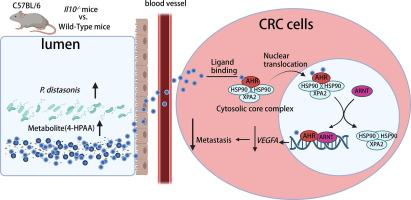当前位置:
X-MOL 学术
›
J. Adv. Res.
›
论文详情
Our official English website, www.x-mol.net, welcomes your
feedback! (Note: you will need to create a separate account there.)
Interleukin-10 deficiency suppresses colorectal cancer metastasis by enriching gut Parabacteroides distasonis
Journal of Advanced Research ( IF 11.4 ) Pub Date : 2024-11-19 , DOI: 10.1016/j.jare.2024.11.024 Jing Yu, Lili Feng, Zhanhao Luo, Jingyi Yang, Qiang Zhang, Chen Liu, Dayi Liang, Yanchun Xie, Hongmin Li, Junli Gong, Zhen He, Ping Lan
Journal of Advanced Research ( IF 11.4 ) Pub Date : 2024-11-19 , DOI: 10.1016/j.jare.2024.11.024 Jing Yu, Lili Feng, Zhanhao Luo, Jingyi Yang, Qiang Zhang, Chen Liu, Dayi Liang, Yanchun Xie, Hongmin Li, Junli Gong, Zhen He, Ping Lan

|
The intricate interplay of interleukin-10 (IL-10) and gut microbiota influences tumor development and progression, yet the impacts on colorectal cancer (CRC) metastasis remain incompletely understood.
中文翻译:

白细胞介素 10 缺乏症通过富集肠道副拟杆菌 distasonis 抑制结直肠癌转移
白细胞介素 10 (IL-10) 和肠道菌群错综复杂的相互作用影响肿瘤的发展和进展,但对结直肠癌 (CRC) 转移的影响仍不完全清楚。
更新日期:2024-11-19
中文翻译:

白细胞介素 10 缺乏症通过富集肠道副拟杆菌 distasonis 抑制结直肠癌转移
白细胞介素 10 (IL-10) 和肠道菌群错综复杂的相互作用影响肿瘤的发展和进展,但对结直肠癌 (CRC) 转移的影响仍不完全清楚。

































 京公网安备 11010802027423号
京公网安备 11010802027423号